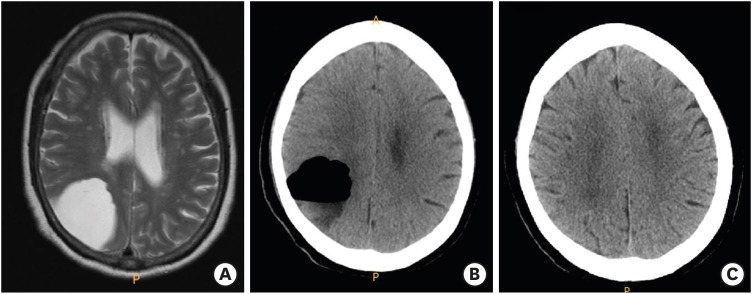Korean J Neurotrauma.
2019 Oct;15(2):170-175. 10.13004/kjnt.2019.15.e18.
Disappearance of Arachnoid Cyst after Burrhole Trephination: Case Series
- Affiliations
-
- 1Department of Neurosurgery, Soonchunhyang University Seoul Hospital, Seoul, Korea. profoundph@naver.com
- KMID: 2461123
- DOI: http://doi.org/10.13004/kjnt.2019.15.e18
Abstract
- We report 3 cases of arachnoid cysts (ACs) that completely disappeared after burr hole drainage, without cyst fenestration into the subarachnoid space or cystoperitoneal shunt. The first patient was a 21-year-old female with an AC of the right cerebral convexity, found incidentally. After endoscopic AC fenestration was performed, the patient complained of persistent headache. Two-month postoperative brain imaging revealed reaccumulated AC and associated multi-stage subdural hematoma. Burr hole drainage was performed to resolve the chronic subdural hematoma (CSDH). Three months later, brain computed tomography showed that the CSDH and the AC had disappeared. The second patient was an 11-year-old male who had a history of trauma 1 month prior to presentation at the clinic. Brain magnetic resonance imaging revealed an AC in the left sylvian fissure with CSDH. We performed burr hole drainage to treat the CSDH first. Subsequently, the AC as well as the CSDH disappeared. The third case was an AC of the right parietal convexity, found incidentally. Only burr hole drainage was performed, following which, the AC disappeared. This case series shows that an AC can disappear naturally after rupture into the subdural space by trauma or the burr hole procedure.
MeSH Terms
Figure
Reference
-
1. Arunkumar MJ, Haran RP, Chandy MJ. Spontaneous fluctuation in the size of a midline posterior fossa arachnoid cyst. Br J Neurosurg. 1999; 13:326–328. PMID: 10562848.2. Bilginer B, Onal MB, Oguz KK, Akalan N. Arachnoid cyst associated with subdural hematoma: report of three cases and review of the literature. Childs Nerv Syst. 2009; 25:119–124. PMID: 18839182.
Article3. Catala M, Poirier J. Arachnoid cysts: histologic, embryologic and physiopathologic review. Rev Neurol (Paris). 1998; 154:489–501. PMID: 9773082.4. Cincu R, Agrawal A, Eiras J. Intracranial arachnoid cysts: current concepts and treatment alternatives. Clin Neurol Neurosurg. 2007; 109:837–843. PMID: 17764831.
Article5. Cullis PA, Gilroy J. Arachnoid cyst with rupture into the subdural space. J Neurol Neurosurg Psychiatry. 1983; 46:454–456. PMID: 6101185.
Article6. Domenicucci M, Russo N, Giugni E, Pierallini A. Relationship between supratentorial arachnoid cyst and chronic subdural hematoma: neuroradiological evidence and surgical treatment. J Neurosurg. 2009; 110:1250–1255. PMID: 18976058.
Article7. Gosalakkal JA. Intracranial arachnoid cysts in children: a review of pathogenesis, clinical features, and management. Pediatr Neurol. 2002; 26:93–98. PMID: 11897472.
Article8. Haines DE, Harkey HL, al-Mefty O. The “subdural” space: a new look at an outdated concept. Neurosurgery. 1993; 32:111–120. PMID: 8421539.9. Kushida Y, Terao H, Shibata I, Shishido M, Seiki Y, Tsutsumi S. Chronic subdural hematoma associated with arachnoid cyst--study of the mechanism of its development. No Shinkei Geka. 1983; 11:1211–1217. PMID: 6664448.10. Martínez-Lage JF, Poza M, Sola J, Puche A. Congenital arachnoid cyst of the lateral ventricles in children. Childs Nerv Syst. 1992; 8:203–206. PMID: 1394251.11. Moon KS, Lee JK, Kim JH, Kim SH. Spontaneous disappearance of a suprasellar arachnoid cyst: case report and review of the literature. Childs Nerv Syst. 2007; 23:99–104. PMID: 16944178.
Article12. Mori T, Fujimoto M, Sakae K, Sakakibara T, Shin H, Yamaki T, et al. Disappearance of arachnoid cysts after head injury. Neurosurgery. 1995; 36:938–941. PMID: 7791985.
Article13. Page A, Paxton RM, Mohan D. A reappraisal of the relationship between arachnoid cysts of the middle fossa and chronic subdural haematoma. J Neurol Neurosurg Psychiatry. 1987; 50:1001–1007. PMID: 3655804.
Article14. Pandey P, Tripathi M, Chandra PS, Singh VP, Mehta VS. Spontaneous decompression of a posterior fossa arachnoid cyst: a case report. Pediatr Neurosurg. 2001; 35:162–163. PMID: 11641628.
Article15. Poirrier AL, Ngosso-Tetanye I, Mouchamps M, Misson JP. Spontaneous arachnoid cyst rupture in a previously asymptomatic child: a case report. Eur J Paediatr Neurol. 2004; 8:247–251. PMID: 15341907.
Article16. Robinson RG. The temporal lobe agenesis syndrome. Brain. 1964; 87:87–106. PMID: 14152215.
Article17. Sprung C, Armbruster B, Koeppen D, Cabraja M. Arachnoid cysts of the middle cranial fossa accompanied by subdural effusions--experience with 60 consecutive cases. Acta Neurochir (Wien). 2011; 153:75–84. PMID: 20931240.
Article18. Takagi K, Sasaki T, Basugi N. Spontaneous disappearance of cerebellopontine angle arachnoid cyst: report of a case. No Shinkei Geka. 1987; 15:295–299. PMID: 3496551.




